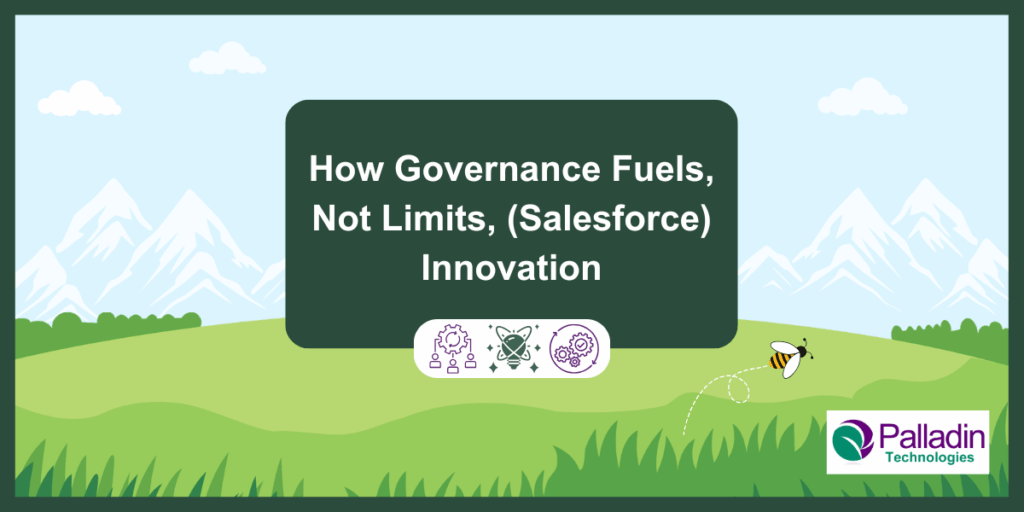Balancing Creativity and Governance
When (Salesforce) projects stall or outright fail, it’s rarely due to a lack of creative ideas; more often, the root cause is a fundamental misalignment in governance and expectations.
Creative governance is essential for tackling complex challenges. This piece aims to clarify why effective project governance, far from being a bureaucratic hindrance, fosters a predictable path to success, especially within Salesforce projects. Governance can be streamlined through trust, transparency, and collaboration, rather than being bogged down by layers of approval.
Why Governance Matters
Effective project governance is key to achieving predictable results. It offers several additional advantages, including:
- Minimizes Surprises: Prevents unexpected issues that lead to delays and rework.
- Fosters Collaboration: Encourages early stakeholder buy-in and a cooperative environment.
- Builds Trust: Cultivates a culture of ownership and accountability.
How to Implement Effective Governance
Establishing effective project governance doesn’t require a complex framework. We can implement strong governance for projects of any size – small or large – by following these steps:
- Regular, Planned Cadence: Establish consistent check-ins.
- Simple Agenda: Keep discussions focused and clear.
- Team Involvement: Emphasize collaboration over individual responsibility.
Typical Governance on Salesforce Projects
Governance for Salesforce projects involves a blend of cadences, which should be tailored to the specific nature, scale, and team size of your implementation.
- Toll Gates: Decisions at each phase based on team readiness, measured by artifact completion checklists or prototyping and testing.
- Design/Solution Reviews: Senior team member reviews to preempt issues in later stages.
- Regular Meetings (PMO-led): Common in large projects to track parallel project health, mitigate conflicting requirements, and aid release planning across teams.
Why Creativity Matters
Cultivating a creative work environment, on the other hand, is crucial for team motivation, as it provides the necessary freedom and space for ideas to flourish. Creativity drives both innovation in problem-solving and the cultivation of collaboration, teamwork, and shared growth. Essential traits for developing creativity include courage and curiosity.
Tying Governance and Creativity Together
Early planning and a sustained focus on output help teams become productive from day one. Empowering teams as project experts, while governance boards provide guidance, strikes the ideal balance between oversight and innovation. This flexible approach leads to confident, collaborative team building.
We can achieve this through several key mechanisms:
- Team Agency: Granting teams autonomy and ownership cultivates responsibility, encourages proactive problem-solving, and promotes innovative solutions. This allows for decision-making tailored to specific contexts, rather than relying on top-down directives.
- Clear Boundaries: Clear boundaries are essential for innovation, providing guardrails for safe development. They define expectations, resources, and ethics, preventing chaos and ensuring strategic alignment.
- Continuous feedback loops: Adaptive governance relies on consistent feedback, not just performance reviews. This ongoing dialogue enables continuous learning, real-time adjustments, and a culture of continuous improvement by identifying challenges and celebrating successes.
- Critical Thinking: Flexible governance fosters critical thinking by encouraging individuals and teams to analyze, evaluate, and make reasoned decisions, which is crucial for innovation.
- Adaptive frameworks: Adaptive frameworks are fluid, responsive guidelines that evolve with projects, market conditions, or new insights, ensuring governance remains relevant and supportive.
Conclusion
Without governance, teams can feel adrift and take longer to achieve productivity. Implementing structured measures provides a sense of direction, support, and consistency for both new and established teams.
Flexible governance aims to enable innovation rather than hinder it. By balancing structure and freedom, organizations can foster an environment where new ideas are encouraged, developed, and brought to life. This transforms governance from a bureaucratic obstacle into a strategic advantage, driving sustained creativity and competitive edge.
Learn More About Partnering With Us!
Innovation Product Manager
Divya is an Innovation Product Manager and a seasoned Salesforce expert with 11 years of experience. She began her career as a developer before transitioning into functional and strategic roles across various industries. Her expertise spans Salesforce consulting, business analysis, and IT leadership, making her a valuable asset in driving innovation and process optimization. Before joining Palladin, Divya held key roles at Johnson Controls, Deloitte, and Appirio, where she led Salesforce enhancements, product strategy, and large-scale business transformations. She holds multiple Salesforce certifications, including Sales Cloud Consultant, Experience Cloud Consultant, and Platform App Builder, along with a BCS Business Analysis certification. Divya is passionate about leveraging technology to solve complex business challenges, enhance efficiency, and drive digital transformation.

